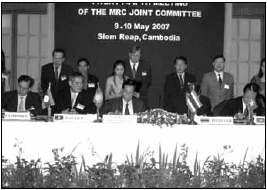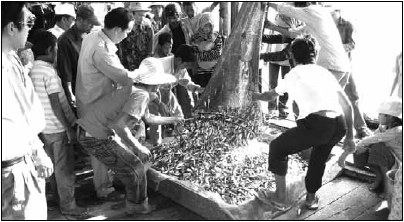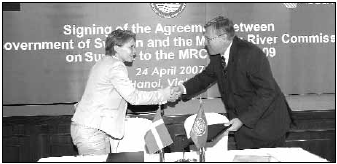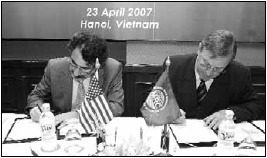Mekong News - Archive
April - June 2007
Issue 2007/2
In this issue:
- MRC launches new navigation aid system
- Joint Committee discusses MRC progress
- Record haul for dai fishery
- Basin wetlands work to continue
- Sweden provides U$$6.4m for MRC programmes
- MRC, USAID sign arrangement to support transboundary cooperation
- International conference on the MRC
- MRC holds first regional gender workshop
- Information Products
- Upcoming events
MRC launches new navigation aid system

Making a splash in the Mekong: the
first buoy is dropped
into position. PHOTO:
GARRISON PHOTOGRAPHY
On 5th April 2007, the Mekong River Commission laid the inaugural navigational buoy in Chaktomouk area in the access channel to Phnom Penh Port as the start of what will be the first 24-hour navigational aid system on the Mekong in Cambodia. The navigational aids project is part of the MRC's Navigation Programme which is funded by the Government of Belgium.
The buoy was released in an onboard ceremony by H.E. Mr. Sun Chanthol, Minister of Public Works and Transport, H.E. Mr Tram Iv Trek, Secretary of State of the Ministry of Public Works and Vice Chairman of the Cambodia National Mekong Committee, H.E. Mr Jan Matthysen, Ambassador of Belgium and Dr Olivier Cogels, Chief Executive Officer of the Mekong River Commission Secretariat.
Over the next six months, the Aids to Navigation on the Mekong River Project, will install 56 buoys of three types and 12 leading markers over a 100km stretch of the Mekong River. These buoys will mark a safe channel from Phnom Penh Port to the Cambodia-Viet Nam border – the busiest stretch of the Mekong in Cambodia.
The installation of this internationally recognised system of aids to navigation such as buoys, beacons and shore marks, aims to improve safety and efficiency of navigation so that sea-going vessels and inland barges can safely navigate for 24 hours a day in safety.
Shipping is being hindered by shoals, sand banks, ship wrecks and other obstacles. A lack of aids to navigation is the main cause for various accidents from collisions, ships running aground, and risks for pollution, threatening the ecosystem of the river. This also results in a loss of opportunities as investors see navigation as an adventure rather than a transport mode which can provide a reliable schedule for cargo forwarders.
Pollution from spills is particularly important in this region as millions of the people in the Mekong Basin, particularly in Cambodia, depend largely on the resources of the Mekong for their daily living and a pollution accident could be a serious threat to their livelihoods. Proper channel marking will reduce these risks significantly.

From Left: Mr John Sugarman of Australian
Maritime Systems,
H.E. Mr Sun Chanthol and Dr Cogels complete the handover of
the first buoy to Phnom Penh Port.
This system will be of enormous assistance to Cambodia in increasing its export potential, as the river will become a reliable and more economic form of transport. The quality of waterborne transport will be improved, waiting times will be shortened, night navigation will be possible, and river transportation will be more cost-effective and efficient. A cost benefit study has shown that up to US$45 million can be saved in annual transport costs if the Mekong River system can be used to transport containers between Phnom Penh, Can Tho and Ho Chi Minh City, and also directly to overseas ports such as Singapore and Hong Kong.
This stretch of the river is part of the international shipping route that connects Phnom Penh Port with the sea whilst passing through the delta in Viet Nam. Although international shipping from countries outside the Basin to and from Cambodia and Viet Nam on the Mekong River System exists, there is great potential for increased maritime shipping.
This initiative should assist in supporting the overall development of navigation on the Mekong.
The CEO of the Mekong River Commission Secretariat Dr Olivier Cogels said this initial installation project was part of the MRC's bigger plans to open up the Mekong and reduce physical and non-physical barriers to free navigation.
As part of its mandate, the Navigation Programme is in the process of facilitating a Navigation Protocol between Cambodia and Viet Nam and establishing a legal framework between those two countries, which will facilitate passage of vessels and cargo, and boost confidence among investors.
This framework will also directly benefit the other Mekong nations and overseas partners. In fact, shipping companies from Thailand already send vessels to Phnom Penh via the Mekong River.
The MRC, through the Navigation Programme is the Executing Agency of the Installation of Aids to Navigation Project. The 12-month project started in November 2006 and is being implemented by Australian Maritime Systems Ltd in cooperation with Phnom Penh Autonomous Port and the Waterways Department of the Ministry of Public Works and Transport.
The equipment is made by Mobilis Co Ltd (France) and distributed by Tempest Co Ltd. (Belgium).
For information contact: Lieven Geerinck, geerinck[at]mrcmekong.org
or Hiek Phirun, phirun[at]mrcmekong.org
Note: replace [at] with @ in the email address.
Joint Committee discusses MRC progress

JC members sign the minutes at the
conclusion
of the 25th Joint Committee Meeting in Siem
Reap.
DELEGATES at the 25th Joint Committee Meeting held in Siem Reap, Cambodia on 9-10 May 2007 heard that the work of the Mekong River Commission now showed an increased sense of ownership by its Member Countries.
The MRC had consolidated as a strong and cooperative forum for the joint development of the water and related resources of the Mekong River Basin.
MRC Secretariat Chief Executive Officer Dr Olivier Cogels told the meeting that the implementation of the MRC’s 2006-2010 Strategic Plan was going to schedule. A number of significant activities regarding cooperation with investment banks were already underway. Cooperation between Member States was continuing in strength and there was a growing cooperation with upstream countries, based on a stepwise approach and mutual trust.
The meeting heard that the organisation was financially sound and that donor support had been strong over the past eight months with seven agreements, worth more than US$25 million, being signed with the Governments of Australia, Denmark, Finland, Germany, Japan and Sweden and with the European Commission. Techncial assistance was also being provided by experts from France, Germany and Japan.
The meeting discussed the progress of the work of the MRC and heard that concrete outputs had been produced in the Environment, Navigation, Flood Mitigation and Management, Agriculture, Irrigation and Forestry Programmes.
The Fisheries Programme, in particular, was commended for its “world class” performance.
The newly-established Information Knowledge Management Programme was now funded and had already recorded some significant outputs.
Under the Integrated Capacity Building Programme there had been a successful implementation of the Gender Mainstreaming Project, while funding was being sought for Phase 2 of the Junior Riparian Project.
Discussions were also held on the second phase of the Basin Development Plan and the form of the future work of the of the Water Utilisation Programme.
The meeting considered the report on the Hydrological Conditions in the Lower Mekong Basin, which presented data on water levels and river flows recorded in the last wet season.
Record haul for dai fishery

MRC data collectors preparing to sample
landings from a dai.
CAMBODIA'S dai fishery landings in 2006-07 were the second-highest on record, according to figures from the the Cambodian Fisheries Administration (FiA).
Since 1995 the MRC Fisheries Programme has been supporting the FiA to formally monitor the stationary trawl or dai fishery of the Tonle Sap River in Kandal Province and Phnom Penh Municipality.
Combined landings from the 64 dai nets are estimated at 18,200 tonnes, second only to the 2005-6 season, which recorded the highest ever landings. The 2006-2007 catch is well above average and represents nearly 4 percent of estimated total inland fisheries landings for this season. The estimated value is 12.9 billion riel (US$3.2 million).
While the number of dais allowed to fish is strictly controlled by licensing, MRC data collectors reported an increase in the use of diesel engines to haul the nets this year. These might allow operators to set and haul nets more often each day, effectively increasing their fishing power.
Landings from the dai fishery are regarded as an important indicator of the health of fishery resources of the Great Lake-Tonle Sap. Since 1995, estimated annual landings have exhibited considerable fluctuation around the estimated mean of approximately 15,000 tonnes a year. Hydrological conditions within the system described using a simple flood index have been employed to explain these large inter-annual variations in landings. Other explanatory variables have included changes in illegal gear use as well as training and awarenessraising activities.
During the next two years, the Fisheries Ecology, Valuation and Mitigation Component of the MRC's Fisheries Programme will seek to improve the understanding of the response of fish biomass to changes in river hydrology and fishing effort by employing indicators of biomass that attempt to account for changes in fishing effort and gear efficiency, as well as a range of alternative quantitative descriptors of hydrological conditions.
The component is currently preparing a collaborative research proposal with Murdoch University in Australia to undertake this research with financial support from the Australian Centre for International Agricultural Research.
The research, which is expected to begin next year, will also seek to determine if any significant changes in fish diversity and rates of exploitation have occurred in the fishery since formal monitoring began. It will also undertake a thorough investigation of the dai monitoring database to check for any errors in the dataset and to ensure that the catch and effort estimation methodologies are correct.
For information contact: Dr Ashley Halls, halls[at]mrcmekong.org - replace [at] with @ in the email address.
Basin wetlands work to continue
THE first phase of the Mekong Wetlands Biodiversity Conservation and Sustainable Use Programme (MWBP) has been successfully completed, but due to changes in the funding priorities of the Global Environment Fund of the United Nations it will be unable to continue its second phase.
The programme, which was managed jointly by the United Nations Development Programme, the World Conservation Union (IUCN) and the MRC, held its final seminar at the MRC Secretariat in Vientiane on 27 March 2007.
Since the launch of its first phase in mid-2004, the MWBP had been working at four wetlands demonstration sites in Stung Treng, Cambodia; in Attapeu, Lao PDR; the Songkhram River Basin in Thailand and the Plain of Reeds in Viet Nam. Among its major achievements, were establishing a wetlands working group in Cambodia's Ministry of Agriculture, Forestry and Fisheries, and preparing Lao PDR to the accede to the Ramsar Convention with Siphandone as its first Ramsar site.
The programme also worked on the possible designation of Thailand's Songkhram River Basin as a new Ramsar site and through scientific work at the Tram Chim National Park, assisted Viet Nam to change its policy on Special Use Forests.
During the seminar, the meeting heard that the evaluation report had singled out MRC’s activities as successful. MRC's mapping of the four wetland sites and wetlands basinwide was complete and the Wetlands Map Service is now available on the MRC Portal (http://portal.mrcmekong.org).
This portal provides access to information on the wetlands via an interactive map. It integrates GIS and earth observation layers with field survey data including photographs and provides access to additional information by linking to other map layers, relevant websites and documentation.
The MRC's Environment Programme will continue its wetlands activities in the Lower Mekong Basin. It has been instrumental in supporting the accession of Lao PDR to the Ramsar convention and developing transboundary wetland cooperation throughout the Basin. For information contact: Dr Charlotte MacAlister, charlotte[at]mrcmekong.org (replace [at] with @ in the email address).
Sweden provides U$$6.4m for MRC programmes

H.E.Ms Gunilla Carlsson and Dr Olivier
Cogels seal the
agreement with a handshake.
THE Swedish Government will provide US$6.4 million (45 million Swedish Kroner) over a three-year period to support the work of the Mekong River Commission (MRC).
The agreement was signed in Hanoi, Viet Nam on 24 April 2007 by H.E. Ms Gunilla Carlsson, Minister of International Development Cooperation, on behalf of the Government of Sweden and Dr Olivier Cogels, Chief Executive Officer of the MRC Secretariat.
Sweden has supported the MRC for many years, focusing in particular on the Environment Programme, the Basin Development Plan, the Fisheries Programme and on Institutional Support. The renewed support will be used on these four areas.
The Minister said the Swedish support will contribute to an environmentally sustainable use and equitable sharing of benefits from the natural resources related to the Mekong River. She also highlighted the critical role the MRC has to play in Southeast Asia.
Within the Environment Programme the new funding will be focused on stimulating better dissemination of information, continued work on transboundary environmental hot spot issues and close engagement with other MRC programmes to assist with incorporation of environmental concerns. Monitoring and assessment activities will be continued, but with an increased focus on how to make them sustainable in the medium term. A comprehensive environmental flows assessment capacity will be established for the Mekong River Basin.
The Swedish support to the Basin Development Plan will contribute to the overall implementation of the management and development of the water resources of the Mekong basin in an integrated, sustainable and equitable manner for the mutual benefit of the riparian States.
The funding will be used to help develop a rolling basin plan and to identify projects for development as well as to improve the MRC knowledge base and assessment tools and to build capacity in areas where it is required.
Within the Fisheries Programme the support will be used to fund an economic valuation of fisheries in the Lower Mekong Basin and to provide support to the Technical Advisory Body for Fisheries Management, a regional fisheries management body.
The Institutional Support element will provide integrated water resources management capacity support within the MRC Secretariat.
MRC, USAID sign arrangement to support transboundary cooperation

Mr Olivier Carduner USAID’s Mission
Director and
Dr Olivier Cogels sign the new cooperation
arrangement.
THE MRC and the United States Agency for International Development (USAID) signed a new cooperative arrangement to assist MRC member countries in joint planning, cooperation, and prevention of transboundary issues in Hanoi, Viet Nam, on April 23.
The agreement aims to support the development of institutional arrangements, tools and skills for strengthening regional cooperation and addressing areas of potential dispute. Through its regional Environmental Cooperation-Asia (ECO-Asia) Program, USAID will cooperate across the full range of MRC programmes engaged in or planning activities.
USAID, in partnership with the Secretariat, National Mekong Committees, and Line Agencies, will organise a series of activities designed to further strengthen regional cooperation capacity. Through this collaboration, the partners will facilitate counterpart exchanges and cooperation between Mekong countries to promote sharing of best practices in the management of transboundary issues and the development of tools and strategies for addressing potential conflict.
International conference on the MRC

The senior participants in the high
level international
conference in Hanoi.
ON 23-24 April an International Conference on the Mekong River Commission (MRC) was held in Hanoi, Viet Nam. The conference was hosted by the Viet Nam National Mekong Committee and jointly organised with the Government of Denmark.
The high level Conference drew representatives from the MRC Council, as well as government ministers from Denmark, Sweden and Japan to discuss ways to strengthen the MRC to enable it to play a stronger role in the sustainable development of water and related resources in the Mekong Basin, in collaboration with national, regional and international partners.
The themes were: The MRC's comparative advantage; cooperation with upper riparian states China and Myanmar; the working relationship between the MRC, Asian Development Bank (ADB) and the World Bank; and, the MRC and donors.
Participants included representatives from National Mekong Committees and Line Agencies, Dialogue Partners, senior representatives of MRC donor countries, senior members of the World Bank and the ADB, MRC partners and MRC staff.
In a joint statement of the conference's findings there was a reaffirmation of the role of the MRC as an important joint mechanism for informed political dialogue between the Member States and their partners on the sustainable development and use of water and related resources in the Mekong Basin.
It concluded that there were needs to strengthen the organisation in several areas including requesting more support from Member States to ensure that MRC strategies and plans are adequately reflected in national development policies, strategies and plans in all relevant sectors – and vice versa.
There was also a need for more active involvement by the MRC in GMS programmes in the Mekong Basin within its mandate and increased collaboration with the World Bank and the ADB in the identification and preparation of projects and implementation of activities in order to ensure optimal synergies and efficiency.
The conference called for better harmonisation and coordination of the donor community in their support to the MRC. It requested that the MRC, in close coordination with the NMCs, engage with the different basin stakeholders, including civil society and research institutions, in assessing and promoting development interventions in the Mekong Basin.
Conference participants said that appropriate follow up actions to implement these commitments should be taken through the MRC Joint Committee and Council as well as the Donor Consultative Group. Denmark pledged US$535,000 support to effect this implementation.
MRC holds first regional gender workshop
IN APRIL 2007 the MRC Gender Mainstreaming Project held its first Basin-Wide Workshop on Gender Mainstreaming in Water and Related Resources Development in the Lower Mekong Basin (LMB).
The two-day workshop was held at the MRC Secretariat from 11-12 April and brought the national gender teams from the four member countries and the MRCS Gender In-House Network together to draw up a Basinwide Action Plan for Gender Mainstreaming in Water Resources Management.
The meeting heard a brief review of the MRC Gender Milestones as well as updated information on achievements of the Gender Mainstreaming Project. Then each team presented a background of the team’s organisation, coordination scheme, progress, and action plan.
Many countries are already conducting gender awareness and sensitivity training, gender analysis, gender responsive development planning, gender in monitoring and evaluation, but there was an agreed need to increase this. There was also an agreed need to conduct courses on using the MRC Tool Kits for Gender Responsive Mekong River Basin Development within National Mekong Committees and Line Agencies, and training of trainers.
The meeting called for the establishment of sex-disaggregated databases and a system for data collection as well as a seminar or workshop on gender data collection and analysis in water and related resources management in the LMB.
Participants said there was a need to organise consultative meetings with policy-makers as well as to conduct a forum to promote gender awareness and sensitivity in the use and management of water resources in the Mekong River Basin.
Finally there was a need to translate the MRC Gender Strategy, Policy, and Tool Kits into riparian languages and disseminate them to Line Agencies.
At the end of the workshop the group had finalised four national gender action plans and an action plan for the MRC Secretariat; a Basinwide Action Plan; finalised a project timeframe; and strengthened gender networks.
All teams will meet again in April 2008 to report on the progress of the agreed activities.
For information contact:
Dr Sengamphone Chithtalath,
sengamphone[at]@mrcmekong.org (replace [at] with @ in the email
address)
Information Products
Identification of Freshwater Invertebrates of the Mekong and its Tributaries
This textbook has been December 2006 US$25.00 |
Mekong River and Selected Tributaries MRC Technical Paper No 13
This report documents the findings of field work which examines species composition and variability at 20 sites across the Lower Mekong Basin and identifies those physical and chemical factors that most strongly correlate with variations in these biological communities. January 2007. US$5.00 (plus postage) |
|
Annual Mekong Flood Report 2006
The Annual Mekong Flood Report 2006 takes a historical look at the flood regime of the Mekong River and allows the reader to put modern floods into perspective. The report includes much hydrological information on the annual Mekong flood as well as specific country reports on the 2006 flood with details of damage and loss. April 2007 US$10.00 (plus postage) |
Catch & Culture Issue 13/1
The latest issue of the Fisheries Programme Newsletter includes stories on giant river prawn research in Viet Nam; the dai fisheries annual catch in Cambodia; the Siphandone fishery in Lao PDR; conservation of the Mekong giant catfish; fisheries management in Thailand; and much more. April 2007 Free (postage applies) |
|
| How to order | Contact | |
| All products can be ordered from the MRC Secretariat’s Documentation Centre. Postage costs apply. Mekong region government agencies may write to the MRC to obtain free copies. Check the MRC website for a full list of products. Credit card sales are also available through the website, www.mrcmekong.org/publications/. All products are also available as free downloads from the MRC website. | Documentation Centre Mekong River Commission Secretariat
P.O. Box 6101, 184 Fa Ngoum Road, Unit 18, Ban Sithane Neua,
Sikhottabong District, Vientiane 01000, Lao PDR Phone: (856 21) 263 263 ext: 1122 Fax: (856 21) 263 264 Email: doc.centre[at]mrcmekong.org (replace [at] with @) Website: www.mrcmekong.org |
MRC Informal Donor Meeting
Vientiane, Lao PDR June 2007
Email: schiefer[at]mrcmekong.org
Network of River Basin Organisations 7th
World General Assembly
7-9 June 2007, Debrecen, Hungary
Email: inbo[at]wanadoo.fr
Water for a Changing World – Enhancing
Local Knowledge and Capacity Symposium
13-15 June 2007, Delft, The Netherlands
http://www.unesco.org/water/water_events/Detailed/1502.shtml
2nd IASTED International Conference on
Water Resources Management
20-22 August 2007, Honolulu, Hawaii, United
States
http://www.unesco.org/water/water_events/Detailed/1375.shtml
World Water Week
12-18 August, 2007, Stockholm, Sweden
www.worldwaterweek.org
10th International Riversymposium and
Environmental Flows Conference.
3-6 September, 2007, Brisbane, Australia.
www.riversymposium.com
Fisheries data collection and analysis
Training Course
Wageningen, the Netherlands, October 1-19,
2007.
The course is intended especially for members of government
departments, institutes and nongovernmental
organisations. A limited number of fellowships are available
for this course.
E-mail: training.wi[at]wur.nl www.cdic.wur.nl
Choose a newsletter:




